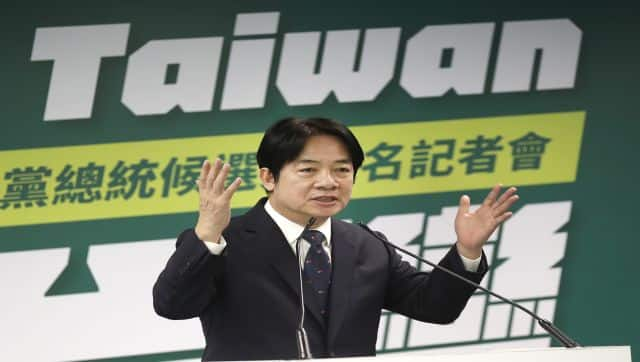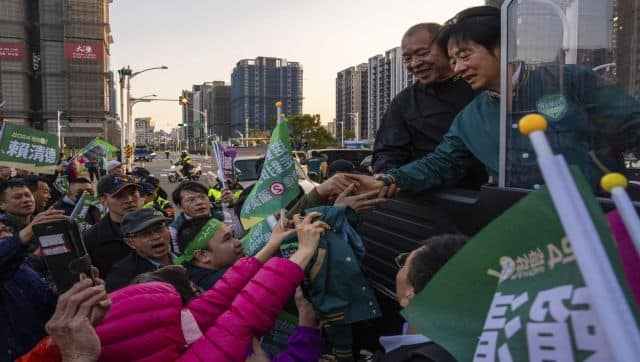Taiwan will hold crucial elections for both its presidential post and the 113-member legislature on Saturday, under intense pressure from China. The results carry significant implications for the entire Asia-Pacific region. Most importantly, the outcomes will be closely watched by China, as it views the island as a Chinese province — a claim rejected by Taiwan’s government. Since President Xi Jinping’s re-election, China has adopted a more aggressive stance towards its neighbour. It openly criticises Taiwan’s current ruling party and attempts to frame the election as a choice between ‘war and peace, prosperity and decline.’ The East Asian country has also increased its military presence in the Taiwan Strait and the South China Sea in recent years. Taiwan, which will choose a new leader to succeed Tsai Ing-wen — Taiwan’s first female president, who is finishing her second term after winning elections in 2016 and 2020 — also remains the biggest source of tension between China and the US. Tsai’s Democratic Progressive Party (DPP) is loathed by China’s Communist leaders because it views Taiwan as a sovereign nation, instead of being part of China as claimed by Beijing. She cannot run again due to term limits. Taiwan was under martial law until 1987 and did not hold its first direct presidential election until 1996, a culmination of decades of struggle for democracy and an end to authoritarian rule. Here are some facts about Taiwan’s election system and how this election will work: Parties: Taiwan’s three main parties contesting the election are the ruling Democratic Progressive Party (DPP), the Kuomintang (KMT) and the Taiwan People’s Party (TPP), only set up in 2019. The DPP currently has a majority in parliament, with 63 seats. The KMT has 38 seats and the TPP has five. The DPP supports Taiwan’s separate identity from China and rejects Beijing’s sovereignty claims, saying only Taiwan’s people can decide their future. [caption id=“attachment_13605062” align=“alignnone” width=“640”] Taiwan’s Vice President Lai Ching-te, also known as William Lai, speaks in Taipei, Taiwan. AP[/caption] The KMT, which ruled China before fleeing to Taiwan after losing a civil war with the Communists in 1949, favours close ties with China but strongly denies being pro-Beijing. The KMT supports the stance that Taiwan and China belong to one single China but each side can interpret what that means, a position welcomed by Beijing. The TPP also wants to re-engage with China. Several other small parties, like the pro-independence Taiwan Statebuilding Party and overtly pro-China New Party, are also standing candidates in the parliamentary elections, but most are unlikely to get many or any seats. Presidential candidates: Three people are standing for president: current Vice President Lai Ching-te — also widely known by his English name William — from the DPP, New Taipei city Mayor Hou Yu-ih from the KMT, and former Taipei mayor Ko Wen-je from the TPP. Lai has almost consistently led opinion polls in the run-up to the vote. New polls have not been allowed to be published from 3 January, in accordance with election law. The new president takes office on 20 May. The presidential term is four years and a president can serve a maximum of two terms in a row. Taiwan’s president is commander-in-chief of the military, appoints the premier, who then forms a cabinet, and signs legislation into law. Timing: Polling stations are open from 8 am to 4 pm (0000 GMT to 0800 GMT). Taiwan media will offer their predictions based on early vote counts on who has won in the early evening. [caption id=“attachment_13605072” align=“alignnone” width=“640”]
Taiwan’s Vice President Lai Ching-te, also known as William Lai, speaks in Taipei, Taiwan. AP[/caption] The KMT, which ruled China before fleeing to Taiwan after losing a civil war with the Communists in 1949, favours close ties with China but strongly denies being pro-Beijing. The KMT supports the stance that Taiwan and China belong to one single China but each side can interpret what that means, a position welcomed by Beijing. The TPP also wants to re-engage with China. Several other small parties, like the pro-independence Taiwan Statebuilding Party and overtly pro-China New Party, are also standing candidates in the parliamentary elections, but most are unlikely to get many or any seats. Presidential candidates: Three people are standing for president: current Vice President Lai Ching-te — also widely known by his English name William — from the DPP, New Taipei city Mayor Hou Yu-ih from the KMT, and former Taipei mayor Ko Wen-je from the TPP. Lai has almost consistently led opinion polls in the run-up to the vote. New polls have not been allowed to be published from 3 January, in accordance with election law. The new president takes office on 20 May. The presidential term is four years and a president can serve a maximum of two terms in a row. Taiwan’s president is commander-in-chief of the military, appoints the premier, who then forms a cabinet, and signs legislation into law. Timing: Polling stations are open from 8 am to 4 pm (0000 GMT to 0800 GMT). Taiwan media will offer their predictions based on early vote counts on who has won in the early evening. [caption id=“attachment_13605072” align=“alignnone” width=“640”] William Lai, Taiwan Democratic Progressive Party (DPP) presidential candidate is greeted by supporters during an election canvass of a neighbourhood in Taoyuan, Taiwan. AP[/caption] The winning and losing candidates will either concede or accept victory later in the evening, though that depends on how close the vote is or whether there is any dispute about vote numbers. The Central Election Commission will only announce the official results much later in the evening, by which time the looser is likely to have already conceded. Voting: Votes are cast in person by putting a mark against the preferred candidate on a slip of paper at designated voting stations, often schools. There is no absentee, early, proxy or electronic voting. Ballots are counted by hand and each vote is displayed for public scrutiny before being counted. For the presidential election, the winner needs only a simple majority to win. There is no run-off election. For parliament, formally called the Legislative Yuan, each voter has two ballots, one for their local district candidate and the other for a party. There are a total of 113 seats in the Legislative Yuan, of which 73 are elected by simple majority in defined constituencies. Voters vote for a candidate in this case. There are 34 seats “at large”, allocated proportionally to each party. Voters vote for a party in this case. A party needs to have at least five per cent of the total party votes to win seats in the Legislative Yuan. Six seats are reserved for Taiwan’s indigenous population. The Legislative Yuan is the main lawmaking body. The term of a Legislative Yuan member is four years. New legislators will take office on 1 February. Some 19.5 million Taiwan citizens are eligible to vote out of a population of more than 23 million. Voters must be aged 20 or older. Turnout: During the last presidential and parliamentary elections in 2020, the turnout was around 75 per cent. With input from Reuters
William Lai, Taiwan Democratic Progressive Party (DPP) presidential candidate is greeted by supporters during an election canvass of a neighbourhood in Taoyuan, Taiwan. AP[/caption] The winning and losing candidates will either concede or accept victory later in the evening, though that depends on how close the vote is or whether there is any dispute about vote numbers. The Central Election Commission will only announce the official results much later in the evening, by which time the looser is likely to have already conceded. Voting: Votes are cast in person by putting a mark against the preferred candidate on a slip of paper at designated voting stations, often schools. There is no absentee, early, proxy or electronic voting. Ballots are counted by hand and each vote is displayed for public scrutiny before being counted. For the presidential election, the winner needs only a simple majority to win. There is no run-off election. For parliament, formally called the Legislative Yuan, each voter has two ballots, one for their local district candidate and the other for a party. There are a total of 113 seats in the Legislative Yuan, of which 73 are elected by simple majority in defined constituencies. Voters vote for a candidate in this case. There are 34 seats “at large”, allocated proportionally to each party. Voters vote for a party in this case. A party needs to have at least five per cent of the total party votes to win seats in the Legislative Yuan. Six seats are reserved for Taiwan’s indigenous population. The Legislative Yuan is the main lawmaking body. The term of a Legislative Yuan member is four years. New legislators will take office on 1 February. Some 19.5 million Taiwan citizens are eligible to vote out of a population of more than 23 million. Voters must be aged 20 or older. Turnout: During the last presidential and parliamentary elections in 2020, the turnout was around 75 per cent. With input from Reuters
Parties, candidates, and voters: A guide to high-stake elections in Taiwan
FP Explainers
• January 13, 2024, 09:02:24 IST
Taiwan was under martial law until 1987 and did not hold its first direct presidential election until 1996, a culmination of decades of struggle for democracy and an end to authoritarian rule. Here are some facts about Taiwan’s election system and how this election will work
Advertisement
)
End of Article